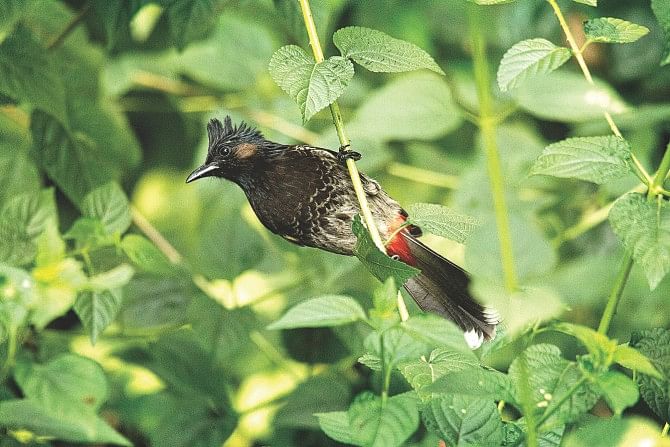Bulbul

Monsoon is close to end. With most migrant birds gone, the bird-watcher's fancy turns to our year-round local birds. Among them, which better to watch than the Bulbul? With its distinctive crested head, acrobatic flight and playful antics, this bird can keep you entertained for a long time. Although its call – a harsh quick-quick-quick - is loud rather than sweet, its personality never fails to engage us.
Bulbul is actually a family of birds (Pycnonotidae) with 138 species, spreading out over Africa, through the Middle-East, across South and South—East Asia, reaching east to Indonesia and north to Japan. Some forest variants are called Greenbul and Brownbul. Bulbuls live in a variety of environments though globally their favourite habitat is the rain forest. Here of course they are at ease in urban environments.
Interestingly, the word “Bulbul” is derived from the Farsi meaning “Nightingale.” In Arabic and Farsi languages, “Bulbul” indeed refers to the Nightingale, but in English, Bulbul is the bird under discussion, distinct from the Nightingale. (I suspect that our many songs referring to the melodious songs of the Bulbul are about the Nightingale whose call sounds sweeter.)
Bangladesh hosts nine species of Bulbul. The most common Bulbul is the Red-vented variety (Pycnonotus Cafer, Bangla Bulbul) recognized easily by the crest on its head and the red vent underneath the tail. There are two subspecies of Red-vented Bulbul: Bengalensis and Humayuni. The former is the common black bird we see everywhere. The latter is much lighter in colour and occurs in Chittagong Division.
The Red-vented Bulbul fascinates me with its eating habits. It forages energetically, sometimes hopping on the ground, sometimes exploring bushes and flowers, sometimes searching tree canopies, never staying still for more than a moment. It feeds on insects, nectar and fruits. Occasionally it joins other birds in hunting-and-feeding parties.
I have observed another delightful habit of this friendly bird. It seems to enjoy perching at the end of a thin branch. If the branch swings under its weight, so much the better!
The Red-whiskered Bulbul is somewhat less common and avoids urban areas. It is also less friendly. Recognized by its distinctive red spot behind the eye, I have seen it mostly in countryside and forests. Its Bangla name is Sipahi Bulbul.
The most unusual Bulbul I have seen is the Black-crested Bulbul. Its entire body is yellow, but the neck and head are black. It appears to be wearing a black mask down to its neck. Its white eyes stand out from the dark face, and a neat, tight black crest completes its unusual appearance. It is supposedly common in our forests and villages, but I have only seen it once.
Our other Bulbuls are the Black-headed, Flavescent, White-throated, Olive and Ashy species of Bulbul. Our ninth species, Black Bulbul, is a vagrant, meaning it was sighted here after arriving accidentally, probably due to a storm.
So the next time you spot that crested black bird in your garden, your time spent watching it will probably be time well-spent.
www.facebook.com/tangents.ikabir

 For all latest news, follow The Daily Star's Google News channel.
For all latest news, follow The Daily Star's Google News channel. 



Comments